
Koho Anma
The Art of Traditional Japanese Massage
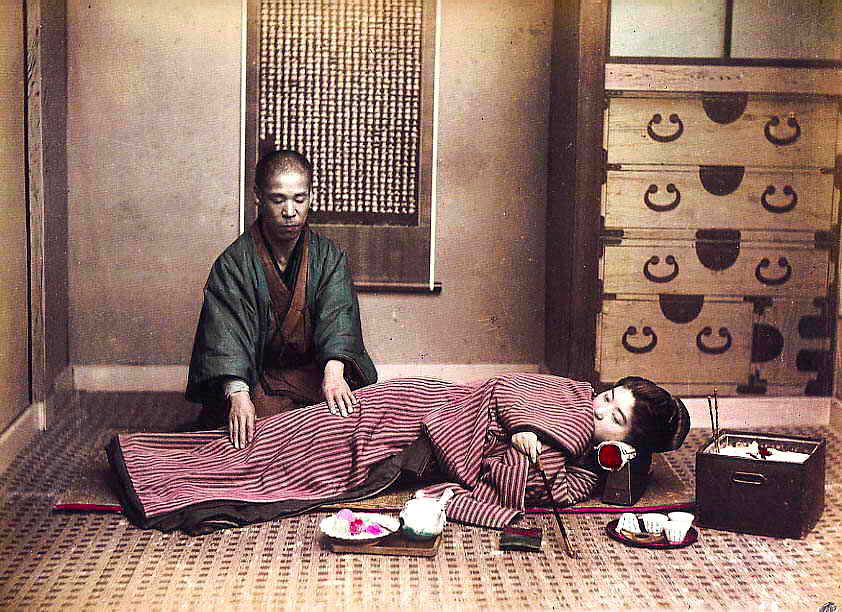


Brief Introduction to Anma
Anma 按摩 means to press 按 (An) and rub 摩 (Ma). It also means to spread peace by rubbing or to calm with the hands. Anma is one of the oldest forms of massage in the world, and it is the oldest form of bodywork in the orient. This therapy comes from ancient China and is at least 7000 years old. Some speculate that Anma’s true origins lie in India and is well over 10,000 years old. Anma was first brought to Japan by warrior monks from China through Korea about 1,500 years ago. In China this therapy is pronounced Anmo. When Anmo was brought to Japan the technique was further refined and developed into its own therapeutic art form. Over the years Anma has influenced the birth of many other forms of massage. Such as Shiatsu, Tuina and Swedish Massage.
Anma traditionally was the base of all oriental medical training. Anma techniques develop the sensitivity of the practitioner’s hands which is considered crucial for the proper application of other areas of medicine. Traditionally one had to train in Anma for three years before beginning any other areas of training such as acupuncture, moxibustion, cupping, etc. which required seven years of training.
Anma therapy is based on the principles of Oriental Medicine. This ancient healing art uses special techniques to stimulate key points (Tsubo) on the surface of the skin to promote the body’s natural self healing abilities. When these points are stimulated they release muscular tension which facilitates the circulation of blood and energy (Kiketsu). This is the intention of Anma massage.
Unlike Western Massage, Anma utilizes no oils, can be done through the clothing with the client either sitting or lying down. Also this therapy can be applied anywhere and at anytime. One can also learn to give Anma to oneself or others. This makes Anma an extremely flexible style of massage, suitable to a wide variety of client needs and environments.


Development of Anmo in China
During the Zhou and Qin Dynasties (1122 B.C – 206 B.C.) All of Chinese medicine was systemized and codified by different treatments. The Su Wen 素問 and Lingshu Jing 靈樞經 medical works were created. This is the first time Anmo is recorded and includes detailed information about massage techniques and treatments.
During the Han Dynasty (206 B.C. – 264 A.D.) Anmo massage methods flourished and developed in China alongside the other main areas of medicine such as: acupuncture, moxibustion, herbology, cupping, breath regulation, self-healing exercises, methods to prevent aging, etc… These were all recorded in the Huangdi Neijing 黃帝內經 “Yellow Emperor’s Classic of Internal Medicine” written by Huang Ti (Yellow Emperor).
During the Jin and Sui Dynasties (265 A.D. – 618 A.D.) there were many internal wars which halted the progress of oriental medicine and Anmo. During this period however, Traditional Chinese Medicine, Anmo, Chinese culture, religion, and martial arts began to travel into Japan through Korea.
During the Tang Dynasty (618 A.D. – 907 A.D.) and onwards Anmo fell into decline throughout China except in the north. During this time doctors began to take some of the techniques from Anmo to create a trauma based therapy called Tuina (推拏). This art re-emerged in the south and is the prevalent bodywork art in China today. Tuina means to “push” 推 and “pull” 拏. The original Anmo techniques in China died out and all that remains is the Tuina branch of the tradition.


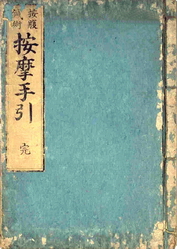
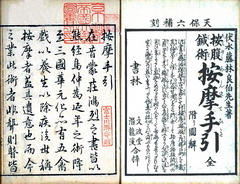
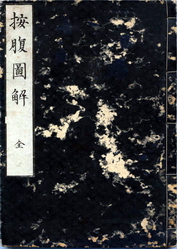
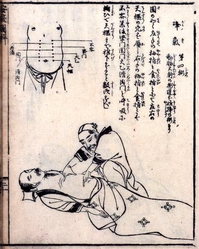
Development of Anma in Japan
Anma in Japan for the most part developed separately from the Chinese Anmo tradition. There are a number of kinds of techniques that are only found in the Japanese form of Anma. In Japan, Anma eventually went into the formation of the art of Shiatsu. This is similar to how the art of Tuina was created in China. Some of the categories of Anma techniques were combined together to create a new art. In this manner, a number of arts were created using the techniques of Anma. Even Swedish massage was created using the 7 core techniques of Anma.
Asuka Periods and Earlier (Early 5th Century to 710 A.D.) Anma and other forms of oriental medicine were introduced into Japan from Korea. During two centuries there was trade with China through Korea. The basis for modern Japanese culture was formulated during this time. In 562 A.D. a Chinese monk and physician by the name of Zhicong (Chiso in Japanese) brought many works on Chinese medicine and became a Japanese citizen. Chiso is said to have brought with him more than 160 volumes of Chinese medical texts which, at the time, represented state-of-the-art medicine. By the 8th century, government-sponsored acupuncture medical schools had been established in Japan and medical knowledge from China continued to be assimilated by the Japanese. However, by the middle of the 10th century, political tensions began to arise between China and Japan, and contact with China became increasingly cut off. It was during this period that Japanese physicians began refining the Chinese system and making their own unique innovations to the practice of Anma and medicine.
Nara and Heian Periods (710 A.D. – 1185) In 718 A.D. a medical school in Japan was established by the government to make a systematic study of acupuncture. There were many degree offered in this school. It required 7 years to earn a degree in acupuncture and moxibustion. It took 3 years to earn a degree to become a “Anmashi” 按摩師 (massage therapist) or to become a “Jugonshi” 呪禁師 (medical spell incantation therapist). Jugonshi were considered indispensable for their spells, their medical treatments of the sick, and their efforts to make childbirth safer. The most outstanding practitioners from among the Jugonshi was appointed “Jugon Hakase” 呪禁博士 (master sorcerer), with only one such fixed position. The Jugon Hakase worked to train and cultivate the “Jugonsei” 呪禁生 (apprentice sorcerers). In 753 A.D a Chinese Buddhist monk named Jianzhen 鑒真 (Ganjin in Japanese) immigrated to Japan with 35 of his disciples who were all doctors. They transmitted their knowledge of oriental medicine to the monks in Japan. In 984 A.D. the Ishinpō 医心方 was written by Yasuyori Tamba. This medical work is 30 scrolls in length. The work is based on the Chinese Bìng Yuánhóu Lún, written by Suí Dynasty author Cháo Yuánfāng. Many of the Ishinpō texts have been lost in China, and have only survived to the present day through their inclusion in the Japanese work. The Ishinpō is the oldest surviving medical work in Japan and is considered a national treasure. It covers all known areas and topics of oriental medicine including Anma. It describes 658 Tsubo (acupoints).
During the Kamakura and Muromachi Periods (1185 A.D. – 1574 A.D.) In Japan this time was a very turbulent period with many wars. Because of the instability of the government the support for the official medical system was abandoned and Japanese medicine began to decline during the 5th and 6th centuries. Anma as well as the other branches of oriental medicine were kept alive by the common people within their families.
Momoyama Period (1575 A.D. – 1602) End of the Sengoku Jidai (warring states period). During this time the capitol was moved from Western Japan to the East near Yokohama and across from Tokyo. Society became stable once again and many new developments were made in the medical field including Anma.
Edo Period (1602 A.D. – 1868) in 1602 Japan’s capitol moved to Edo (Tokyo). Development of Anma and oriental medicine had reached its peek in this period. Many new techniques, text, and schools were established in Tokyo. The Edo Period was the was time Japan was introduced to Western medical knowledge such as anatomy and physiology. This came from the Dutch Trading Company. They were the first Western company to have commerce with Japan and their physicians. With this exchange of knowledge Anma, acupuncture, and other oriental medical arts were taught to Dutch physicians who then brought them back to Europe. During the middle of the 19th century, shortly before the Shoguns fell, a Shogun regulation was made that only the blind were permitted to be practitioners of Anma as a form of welfare. Many blind took over the occupation and gave massage for relaxation purposes (Genko Anma) instead of for therapy (Koho Anma). A lot of technical and clinical knowledge was lost during this time due to the change in practitioners of Anma.
Meiji Period (1868 A.D. – 1912) This is the time in Japan when the fall of the Shuguns happened and was replaced by imperialism. The Japanese government was modeled after the Western influences which had entered Japan. Changes where made to make Japanese society more Western. Western medicine became the primary treatment and the first choice for patients to receive. This greatly threaten the tradition of Anma and nearly wiped out the traditional therapeutic value of Anma and Oriental medicine. Anma was still maintained as an occupation for the blind. At the end of this period the government created regulations requiring licensing of all Anma practitioners. Western style of massage and the use of the massage table were introduced to Japan at this time.
Taiso, Showa, and the Modern Period (1912 to Current) Info Coming Soon


Schools of Anma in Japan
The main traditions or schools of Anma in Japan are:
藤林流按摩 Fujibayashi Ryu Anma founded by: Fujibayashi Ryohaku
杉山流按摩 Sugiyama Ryu Anma founded by: Sugiyama Waichi
皆川流按摩 Minagawa Ryu Anma founded by:
Most schools of Anma alive today can be traced back the the Fujibayashi Ryu 藤林流. In Japan, Anma was practiced in government-sponsored hospitals. Anma as a unique system was founded in 1320 by Akashi Kan Ichi. Anma was popularized in the seventeenth century by acupuncturist Sugiyama Waichi, and around the same time the first books on the subject, including Fujibayashi Ryohaku’s Anma Tebiki (Anma Hand Procedures), appeared. The Fujibayashi school is the foundation of modern Anma.


The Effects of Anma Therapy
Anma massage is a way to balance the body and calm irritated nerves. It normalizes sluggish bodily functions and is used to keep the body healthy and strong. Anma reduces tension, increases circulation and revives and rejuvenates the body while enabling the body to also deeply relax. When tensions are released in the body the immune system functions smoothly. This allows the body to adapt to environmental changes and resist illness. Tension in the body is caused by a build up of lactic acid and is a result of fatigue, trauma, stress, chemical imbalances and above all poor circulation. During Anma massage, muscles relax which allows blood and energy (Kiketsu) to flow freely, then toxins are released and eliminated. Unlike Western Medicine, Anma therapy does not ignore simple symptoms of everyday complaints. These symptoms of headache, dizziness, back pains, etc. are considered an expression of the condition of the body as a whole. Anma responds before these symptoms or imbalances can do further damage to the body which leads to “dis-ease”.


The Various Uses of Anma Massage
Anma massage compliments your medical care by allowing you to take a vital part in getting and staying well. In addition to maintaining health, Anma can also be used to relieve and prevent sports injuries, compliment chiropractic treatments, and restore and balance the emotions. Psychotherapy patients benefit greatly from this. Since ancient times, Anma has been used as a beauty treatment and has many cosmetic benefits. Such as, beautifying the skin, face, and the eyes. Anma massage therapy is also applied for a wide range of ailments such as, headache, colds, asthma, numbness, high or low blood pressure, constipation, stomach cramps, menstrual irregularity, sexual vitality, and insomnia.
One of the most important uses of Anma is its use in effecting the quality of our breathing. When our breath is shallow, all the body’s functions become sluggish. Anma promotes deep long breaths which aids the release of blockages in our energy pathways (Keiraku). This process increases our resistance to illness. Anma is not only used to restore health but is also instrumental in assisting you in discovering your own healing potential. This can at times be an overwhelming blessing.


The Nine Major Technique Categories of Anma
See article on: Anma Shugi 按摩手技
There are nine major categories of techniques within the art of Anma. Seven are original and two were added later on: (Kyosatsu Ho and Haaku Ho). Also, the Kyokute Ho methods are only found within the Japanese tradition of Anma and not in any other art form. Each section allows you to work the body in a uniquely different way. These nine sections create various effects that assist in the achievement of the goals of Anma Therapy. During an Anma massage all nine areas are utilized which creates a very complete full body therapy. In Japan some therapist specialize in applying only three or four sections of techniques in combination for their practice. Another use of Anma techniques is the cultivation of the therapist’s own health. As a whole human beings have grown very weak in health, endurance, and we use less of our brain’s capacity. Anma techniques are not only designed to help assist the client increase their health but when applied correctly these nine sections of techniques cultivate the therapists health and deepen our consciousness and expand our awareness as well. So Anma massage is also a kind of spiritual practice and meditation which allows one to become a better human being. These techniques are directed at specific Tsubo (vital points) and Keiraku (meridian energy pathways) of the body. Methods of Anpuku 按腹 (abdominal palpitation and therapy), developed by Shinsai Ota in the seventeenth century, are also used. The art of Anma is only one science within many teachings from the tradition of Do-In Ankyo. This was developed by Chinese Taoist Mountain Ascetics, known as Sennin or Jiyujin (Free Men) in Japan.
1. Keisatsu Ho 軽擦法 Light stroking techniques also known as Anbu Ho 按撫法
2. Kyosatsu Ho 強擦法 Rotation & stroking with heavy pressure also known as Annetsu Ho 按捏法
3. Junen Ho 柔念法 Kneading techniques also known as Junetsu Ho 柔捏法
4. Appaku Ho 圧迫法 Pressure techniques
5. Shinsen Ho 振せ法 Vibration techniques
-Gaishin 外振 Outer vibration
-Naishin 内振 Inner vibration
6. Haaku Ho 把握法 Gripping and squeezing techniques
7. Koda Ho 卯打法 Percussion techniques
8. Kyokute Ho 曲手法 Melodious bending hand percussion techniques
9. Undo Ho 運動法 Movement, stretching and rehabilitation techniques
-Jido Undo Ho 自動運動法 Movement by yourself combined with equipment
-Tado Undo Ho 他動運動法 Movement by the therapist
-Shincho Undo Ho 伸张運動法 Stretching methods
-Teiko Undo Ho 抵抗運動法 Testing, resistance and exercising methods
-Kyosei Ho 矯正法 Structural diagnosis bone and joint adjustment methods


Besides these nine major areas of hand techniques, the art of Anma has many areas of eastern medical theory and study such as:
Ki – (Inner Energy) broken into three major types:
a. Ten Ki (Heaven Energy)
b. Chi Ki (Earth Energy)
c. Jin Ki (Human Energy)
Keiraku Chiryo – (Meridian energy pathway treatment)
Tsubo – Acupoint study broken into three major sections:
a. Keiketsu Tsubo – those points that are on the meridians
b. Kiketsu Tsubo – those points not on the meridians
c. Aishi Tsubo – natural points not related to the meridian
Shindan – Eastern methods of diagnosis are broken down into two major categories: So (Phenomena) and Shin (Individual Symptoms). The “So†category has 3 main sections:
- Ten-So (Heavenly Phenomena) How the movement of the sun, moon and major constellations effect our health and condition. Our psychological makeup and emotions are deeply linked to and regularly effected by Ten-So.
- Chi-So (Earthly Phenomena) How mountains, plains, sea, desert and forest, or the terrains which surround us all affect us.
- Ji-So (Time Phenomena) Changes in the seasons and cycles of day and night.
In Yo Ho – Yin Yang Theory
Gogyo Setsu – Five Element Theory
Kyojitsu – Study of depleted and excessive conditions
Hosha – Tonification & Sedation methods
Zofu – Internal organ study
Teate no Michi and Norito – Palm Healing and Medicinal Prayers: If one was to specialize in these methods one would become a Jugonshi (Medical Spell Incantation Therapist).

Precautions For Receiving Anma Massage
Anma will not be applied in the following situations:
A fever
A contagious illness
Shortly after the client has had surgery
Skin infections
Cancer or Leukemia (May spread the disease)
Within 24 to 48 hours of injury or trauma. It is best to receive Anma without being under the influence of pain medications.
